In today’s competitive B2B landscape, the lead research process is a critical component for the success of any SaaS lead generation campaign, with a 2022 study by Demand Gen Report stating that 67% of B2B companies cite lead quality and lead generation as their top challenges.
No wonder then, that the absence of a comprehensive lead research process can spell doom for your B2B sales efforts. Yet, when executed correctly, lead research can be a game-changer to boost conversions.
This guide will help you understand the B2B lead research process in detail, shedding light on its significance & how you can make the most out of it for your own business.
Let’s get started.
Understanding the B2B Lead Research Process: A Deep Dive
Recognizing the nuances of the lead research process is pivotal for any B2B enterprise gunning for market leadership. Before we get down to the nitty gritty of the lead research process, it’s important to first understand what it really entails.
Based on insights collected over the last few years, here’s our take:
Lead Research Meaning
Lead research, at its core, is the systematic approach to finding and vetting potential customers or clients for a business. It’s the bridge between marketing efforts and sales success.
The lead research process has a key role in any B2B lead generation campaign, since it helps ensure that your pipeline is constantly filled with high-quality leads only.
SaaS businesses typically follow one of two methods for lead research. The first involves hiring a dedicated lead researcher, whose sole focus is to sieve through the vast ocean of potential leads, identifying the golden opportunities.
The second is to imbibe the lead research methodology into the very DNA of your sales team, ensuring everyone plays their part in the research continuum.
Regardless of the method chosen, the underlying principles around the lead research process in sales remain rather consistent.
Steps For Performing B2B Sales Prospecting Research
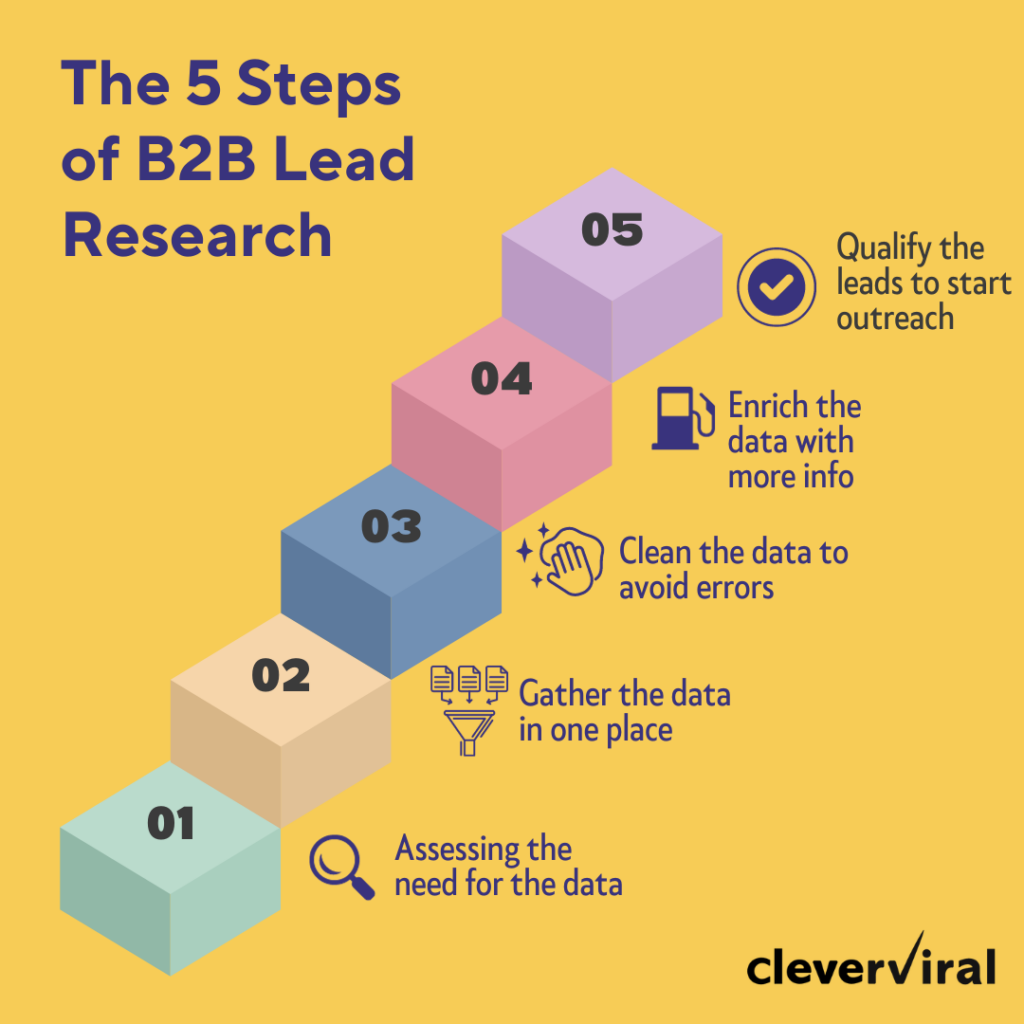
Now that you have a basic understanding of what the B2B lead research process entails, it’s important to strengthen your knowledge further.
In essence, the entire 0 to 1 journey of B2B sales prospecting research contains several critical aspects.
Here’s a closer look at the lead research process steps you need to take:
Initial Assessment
Begin by understanding the DNA of your business. Who is your target audience? What are your overarching business objectives? – these are just some of the questions you need to answer at this moment.
This foundational step is critical, as it ensures that all subsequent efforts are in line with the company’s ethos and goals.
Gathering data
In this digital age, there’s a plethora of avenues to amass potential leads. From LinkedIn to specialized databases, the goal is to compile a rich list of prospects relevant to the business. It’s important to start collecting as many potential leads as possible through these channels, and it usually involves sourcing leads from industry-specific databases, leveraging social media, attending networking events and even mining referrals from existing customers.
The goal here is to create a comprehensive lead pool to propel your lead research process further.
Cleaning the data
Outdated data is often the #1 reason for inaccurate consumer insights which then lead to challenges with inefficient lead generation and wasted marketing dollars.
This not only negatively impacts the business growth, but also the consumer satisfaction and retention.
Typically, any purchased list of leads is already outdated by the time that it falls into your hands.
This is the nature of list-purchasing – as time progresses, positions change, people enter and leave companies, and businesses fundamentally change their models to reflect an evolving economy.
To ensure that the right people are being contacted at all times, data cleansing is important as it weeds out all outdated information.
Data enrichment
Even the most comprehensive lead lists will have gaps. According to a LeadGenius report, nearly 1 to 6.5% of customer data loses validity every month due to the turnover rate. As the VP of Sales or Head of Demand Generation, it’s important to ensure you don’t face the problem of bad data.
This is where data enrichment comes into the picture, helping you fill those voids and ensuring every piece of information about a lead is current, relevant, and actionable.
Lead Qualification
Not every lead is created equal. Some may have higher buying intent than the others, while some might not even be relevant to the ICP you’re targeting. This is where lead qualification comes into the picture.
As the final step of the lead research process, it involves sifting through your lead lists and earmarking those that show genuine potential.
This ensures sales efforts are directed towards prospects with the highest likelihood of conversion.
(P.S. – If you’re someone who’s looking to leverage AI for lead qualification, we recommend checking out our recent article on ChatGPT lead qualification. It’ll not only outline the entire process in detail, but also give you actionable steps to get started.)
Frameworks to Use for A More Efficient Lead Research Process
In the ever-evolving landscape of B2B SaaS, structured approaches are pivotal to ensuring success. A well-defined framework doesn’t just guide the lead research process but optimizes it, ensuring every effort yields maximum returns.
Harnessing the power of established frameworks can make the difference between a lead lost and a lead converted.
Given below are two such approaches:
C.O.M.P framework (Customer, Organization, Media, and Product)
The C.O.M.P framework stands for ‘Customer, Organization, Media and Product’ – which are the 4 major components of a lead research process that gives you a holistic view of the company you’re looking to connect with. It analyzes the business as a whole (right from suppliers to the customers).
Here are some common questions you’d need to answer under this framework:
– Who does the company serve? Is it B2B or individual customers?
– What industry do they sell to? And what challenges do they solve for them?
– What’s the company size & revenue?
– Has the company received any awards or recognition for their products or services?
– What’s the most popular product? Do they also offer bundles?
– Who all are involved in the production? Do they have any suppliers?
You can use the following template to kickstart the lead research process using the C.O.M.P framework:
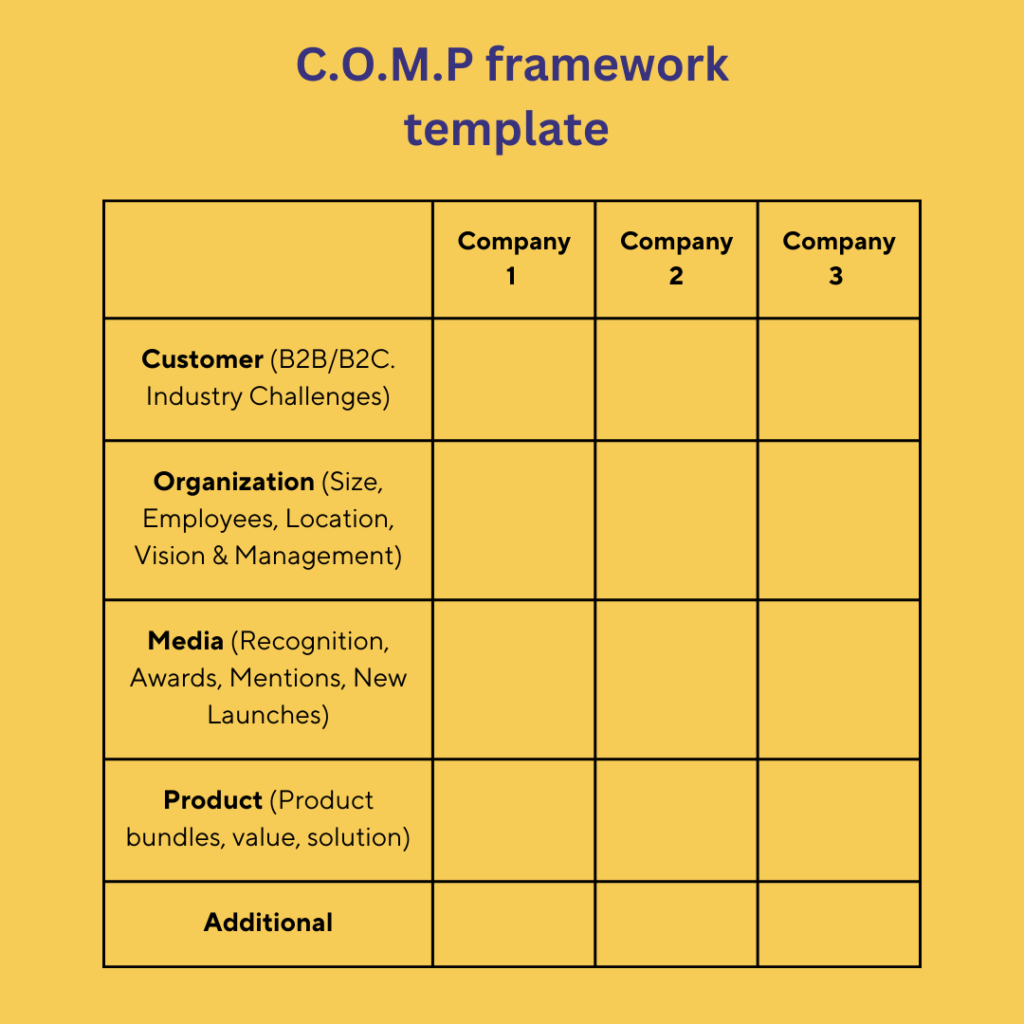
P.A.P framework (Personal, Accomplishments, Past)
The P.A.P framework is yet another lead research process example where you’re considering multiple components of contact research. If you become efficient at using this approach to find information about your prospects, it’ll lead to some amazing results.
Short for ‘Personal, Accomplishments and Past’ – the goal here is to validate if a prospect fits your ICP, and to find messaging angles that can be used to catch their attention.
Here are some crucial questions you need to answer:
– What are the interests of my prospect?
– Have they published any blogs or authored any columns?
– Did they win any award or recognition?
– Did they recently achieve a milestone in their career?
– What’s their educational background?
– Which companies have they worked with previously?
Here’s a quick template based on the P.A.P framework for you:
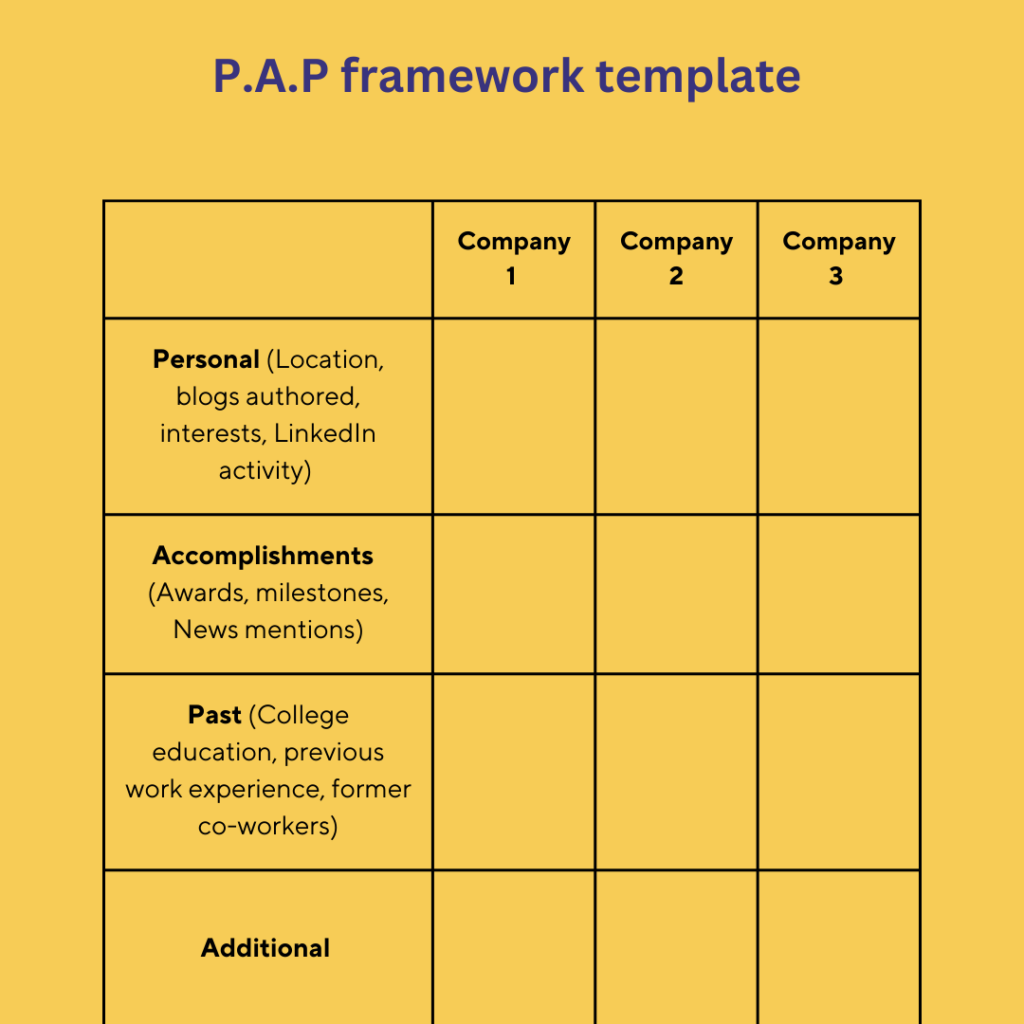
It must be noted that both of these lead research methodologies work well in their own use cases, and must be leveraged fully in order to guide your lead research process towards fruition.
Tools to Power Your Lead Research Process
While important, it can be slightly challenging to find all of the above information manually. This is exactly where lead research tools come into the picture.
They not only follow most of the lead research process steps, but are also useful for automating it in the long-run.
Here are a few tools you can consider:
LinkedIn Sales Navigator
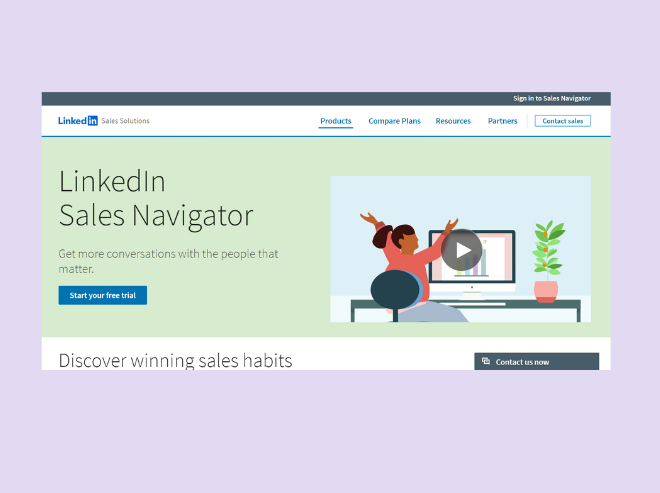
While slightly expensive, LinkedIn’s Sales Navigator is one of the most crucial tools for accelerating the lead research process in sales.
This premium tool is specifically designed for sales professionals and harnesses the vast data of LinkedIn’s professional network to offer advanced search capabilities, real-time insights, and personalized lead recommendations.
Sales teams leveraging the Sales Navigator find themselves better equipped to identify and engage with potential leads, tapping into key decision-makers and influencers within target organizations.
BuzzSumo
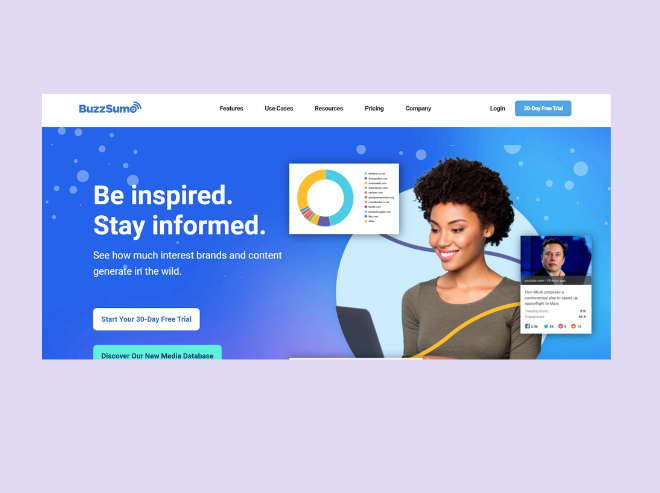
BuzzSumo, while predominantly recognized for its content analytics prowess, presents a unique advantage in the B2B lead research process. By analyzing the most shared and trending content within a specific industry or niche, BuzzSumo enables businesses to identify what type of content or messaging is resonating with their ICP.
By understanding the type of content resonating within a target market, sales professionals can tailor their outreach strategies to mirror the interests and pain points of potential leads.
BuiltWith
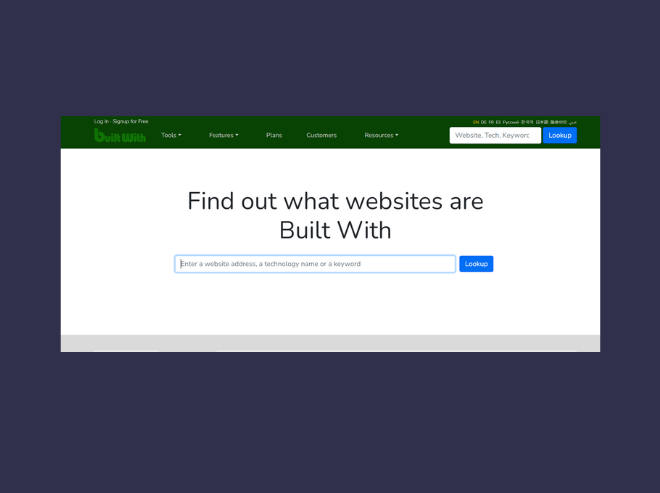
BuiltWith is another extremely useful tool that helps you automate the lead research process in sales.
At its core, BuiltWith provides detailed information about the technologies powering a specific website — from hosting providers to plugins, eCommerce platforms, and advertising networks. In the realm of B2B sales, especially for SaaS and tech companies, this data becomes instrumental.
By understanding what technologies a potential lead or company is currently utilizing, sales professionals can pinpoint their offerings more effectively, highlighting compatibility or presenting their solutions as superior alternatives.
Additionally, monitoring technology adoption trends can indicate market shifts, allowing businesses to identify and target emerging market segments before their competitors.
When considering the lead research process steps, BuiltWith acts as a key differentiator ensuring sales teams are not just informed but strategically positioned when reaching out to potential B2B clients.
Common Pitfalls in the B2B Lead Research Process
Every process has its challenges, and the lead research process is no different. Being forewarned is important.
That being said, here are some common pitfalls you might encounter during the lead research process in sales:
1. Neglecting Data Accuracy: The quality of your lead data is paramount. Neglecting data accuracy can lead to wasted time and resources, as you may be reaching out to invalid or irrelevant contacts.
2. Overlooking Lead Nurturing: Focusing solely on lead generation without a comprehensive lead nurturing strategy can result in missed opportunities. Not all leads are immediately ready for conversion, and nurturing helps build trust and credibility over time.
3. Failure to Adapt: Market dynamics change, and so should your lead research strategy. Failing to adapt to evolving trends and preferences can render your lead data obsolete.
4. Ignoring Compliance: Data privacy regulations are stringent. Ignoring compliance can lead to legal troubles and damage your brand’s reputation.
5. Neglecting Competitor Analysis: Understanding your competitors’ strategies and successes is essential. Neglecting competitor analysis can leave you in the dark, unable to differentiate your offerings effectively.
Best Practices to Ensure A Seamless Lead Research Process
Navigating the intricate landscape of B2B sales requires adopting effective strategies to ensure your lead research process stands out. Here are some best practices that can amplify the results of your efforts:
Focus on Publicly-Available Information
Drawing from the vast reservoirs of publicly available data is not only ethical but immensely fruitful. Platforms like LinkedIn, company websites, and industry reports can provide substantial insights into a company’s structure, its key decision-makers, and industry standing.
While diving deep into the lead research process in sales, it’s imperative to ensure that the information sourced respects privacy norms and provides genuine value in understanding potential leads.
Frame the Uses of Your Lead Research
Simply accumulating data isn’t sufficient. It’s essential to outline clear objectives for the information you gather.
Whether it’s tailoring pitches, understanding a lead’s pain points, or identifying potential upselling opportunities, each piece of data should serve a strategic purpose in the lead research process steps.
By framing your research with intent, you ensure efficiency and a higher probability of successful conversions.
Be Relevant
The B2B space is vast, and not every lead is a good fit. To optimize the lead research process, it’s critical to ensure that the leads you’re pursuing align with your business offerings and values.
By maintaining relevance, you enhance engagement rates, foster genuine relationships, and reduce the friction commonly associated with cold outreaches.
After all, a relevant message stands a better chance of resonating with its audience.
Build Connections
While technology and data are fundamental in modern lead research process examples, the human touch remains irreplaceable. Building genuine connections and fostering relationships with potential leads can set the foundation for long-term partnerships.
This involves engaging with leads on platforms like LinkedIn, attending industry events, or even sharing valuable insights that might benefit them. Remember, in B2B sales, people buy from people, and strong connections can be the differentiator in a competitive market.
By incorporating these best practices, businesses can refine their lead research meaning and ensure that their approach is both efficient and effective in the ever-evolving B2B landscape.
Final Thoughts
Embracing a robust lead research process is the cornerstone for B2B lead gen success. As highlighted, this process is replete with opportunities. With lead research tools also coming into the picture, it’ll ensure businesses aren’t just reaching their audience, but deeply resonating with them.
At Cleverviral, our data intelligence services help you streamline the lead research process from start to finish. We not only help you source the leads, but also qualify and put them into a database for doing outreach at scale.
If you’re looking for a partner to put your data research function on autopilot, feel free to reach out to us.
Frequently Asked Questions
What is the role of a lead researcher?
A lead researcher is an individual tasked with delivering highly-targeted, accurate list of leads for your company.
Their goal is to enhance the efficiency & support the work of your sales team by filling their pipeline with new, piping-fresh leads.
What is the process of lead qualification?
Lead qualification is a systematic process in sales where potential customers or leads are evaluated based on their fit and interest in a product or service. It involves assessing leads against specific criteria such as their needs, budget, purchasing authority, and timeline to determine if they’re worth pursuing, ensuring sales efforts are directed towards prospects most likely to convert.
This step is pivotal in streamlining the sales pipeline, ensuring resources are efficiently allocated, and increasing the likelihood of successful conversions.
How do you research sales leads?
This is complemented by understanding the lead’s challenges, needs, and buying behaviors, often through social media insights, company reports, and digital footprints.
The objective is to gather comprehensive information to tailor sales pitches effectively and increase conversion chances.





